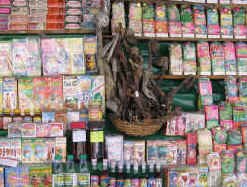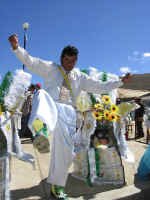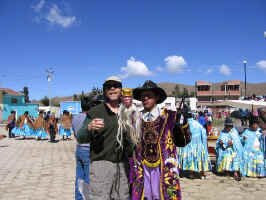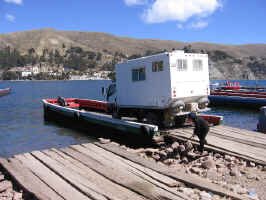May 31 - June 5 - The Bolivian Andes
We spent the day running errands and enjoying this medium-size Bolivian village (Uyuni). Our most time consuming errand was getting the truck washed and cleaned of all the salt water and salt deposits we had driven through. The carwash that was recommended did a terrific job, but we had to wait our turn and then the actual process took about two hours. Can you imagine, a high pressure rinse, soapy wash, lube and rust treatment - all for just $10.00. The rest of the day was spent relaxing and socializing with the interesting people we met, once again, at Minuteman Pizza.
The next day we got an early start and headed off to the town of Potosi. We had debated about our route north and we were told the longer dirt and paved road combination to the northeast to La Paz via Potosi was better than the shorter direct dirt road to La Paz. So, tired of bad roads, we took the long way around. As we had already seen, the scenery was beautiful and the road wasn't bad. We had been warned to keep an eye on the llamas though, as they like to run on to the road. I don't know what it is about these llamas, because we've been seeing them for a couple of weeks, but yes these llamas did like to run onto the road and we had to keep avoiding them.
We finally hit pavement 5km outside of Potosi and had a little celebration for smooth road for the first time in a week. Our celebration was short-lived however as the government hit us up for a toll immediately. Oh well, you gotta pay for the good stuff!
Arriving in Potosi about an hour before dark, we parked the Fuso and started looking for a place to spend the night. We had been warned not to park on the street, so we ignored the "no trucks" sign and drove into town looking for a hotel with parking that had been recommended. We found the hotel with no problem, and they had great parking, but they also had an archway over they driveway that was too short for us to fit under. Darn, now we had to find someplace else and it was getting dark. We did find another hotel with a very helpful manager with a parking lot across the street, but this one had an entrance that turned out to be too narrow and with an angled driveway. So we ended up spending the night in a gas station on the edge of town. They had the radio blasting and trucks coming in all night, but I guess we were just so tired, that we slept quite well, ear plugs are a great thing.
The next morning we drove back into town to explore the old narrow colonial streets on foot. We enjoyed walking around and even got to enjoy a parade complete with a marching band. We got the impression that it was Potosi day as everyone was wearing the town colors of purple and white. Potosi was settled by the Spanish in 1545 to mine the rich silver deposits found in the mountain which rises steeply above the city, Cerro Rico or rich hill. The rich deposits held out for 300 years before they started to decline. Since that time, the demand for tin and zinc have help the city's economy recover. However, the recovery in the price of valuable ore has not truly helped the people who do the actually mining.
A popular tour, in which we declined to partake, takes visitors into the mines which are now operated as cooperatives. Why did we decline? Well, the tours are difficult in the first place. Our Lonely Planet guide book describes the mines as this: "low ceilings and steep, muddy passageways are best visited in your worst clothes. Temperatures can reach 45°C (112°F), and the altitude (over 4000mts/13,000ft) can be extremely taxing. You'll be exposed to noxious chemicals and gases, including silica dust, arsenic gas, acetylene vapors and other trapped mine gases, as well as asbestos deposits and the byproducts of acetylene combustion and the detonation of explosives."
The really bad part of the mine visits is learning that the people who work the mines, even though they are the owners of the mine, still do the work with primitive tools by hand. They work under all the conditions that we as visitors would be exposed to, and they make so little money that their earnings are barely enough to be considered sufficient.
So, after half a day exploring the city, we headed north toward the town of Oruru. Once again the scenery was spectacular and we passed through village after village where the Bolivians were herding their sheep and llamas, and harvesting grain. We also saw people harvesting potatoes using the age old harvesting tradition of the digging stick, although it must be back breaking work. In one of the villages it was market day. We arrived as people were packing up and leaving but we were able to see that some of them were wearing what were probably their fanciest hats with all kinds of decorations on them.
We spent the night in a small town called Pazna where there was a European Union development office with a big, flat parking lot. They graciously allowed us to park there for the night.
The next day we passed by the town of Oruro which is just another big, unattractive mining town so we decided to continue driving. We arrived in the El Alto section of La Paz toward the end of day, and using GPS points, tried to find a hotel with parking that had been recommended. Without having ever been to La Paz, we didn't realize that the city is down in a canyon and you can't see it from the highway. We didn't believe the GPS points were right, but we followed them anyway, through some of the not-so-nice parts of El Alto (which is on the rim of the canyon above La Paz) and then finally down into the canyon and into the nicer Zona Sur section of the city. The points eventually got us close, but we couldn't find the hotel, so after driving around for quite a while, we hired a taxi to take us to their door, a mere half mile or so from where we found the taxi. When all else fails, ask for help. The hotel was very nice, but their parking area was down a hill so it wasn't level, there was no water and the toilets were up the hill closer to the hotel. But it was a secure place to park and even though it was a long drive into the city center, a taxi only cost $3.75.
When we took the taxi into the city center, we were very glad that we had not tried to get there by ourselves in the Fuso. Steep hills, one way streets and narrow colonial drives that would have proved difficult and frustrating. We hope that when we go to leave we will be able to find our way across the city and out tomorrow morning.
We visited the Museum of Gold which has four rooms presenting pre-Columbian silver, gold, copper and ceramic work. The gold display is in a two story vault with a guard at the entrance. There were gold pendants and crowns, jewelry and abstract designs. The gold and silver items were fascinating, but for us we really enjoy the ceramics. The quality of the pots, vases, urns and other items are so amazing, and to consider that they were made nearly 2,000 years ago!
| From there we wandered past colonial era buildings, through street markets into the Mercado de Hechicerķa or Witches' Market. This is more like a market where Shamans would visit. There were herbs and other traditional remedies, as well as items to use for bringing love, children or even wealth. There were things that we might consider bizarre, like the dried llama fetus that is intended to be offered to the earth mother, Pachamama, for good luck to a new business. |
The down side to La Paz is that there is a river that runs through the city that is so polluted and foamy that it is nick-named after a common laundry detergent. The city has a total lack of environmental laws that prevents them from halting the continued pollution by numerous industries. We witnessed the white foam topping the river as well as the people washing not only their vehicles in the water, but their clothing in this toxic stew. Hopefully their government can find the funding to halt this mess.
In the morning we actually found our way out of the city pretty easily but ended up in some nasty traffic up above La Paz in the El Alto section of the city. The highway lanes were blocked with stopped bus traffic and the local police were really nothing more than a joke, just watching the mess and ocasionally blowing their little whistles. We took a few turns, tried to follow our GPS and thinking that we were going the right direction, but there were no signs ever saying "Copacabana" which was our destination city. Finally we got to a toll booth and Copacabana was listed.
Along the way we went through a small town on Lake Titicaca that was having a celebration honoring the Espirito Santo or Holy Ghost. We parked and went to watch. The locals were very friendly and several of the costumed participants insisted that Don have a drink of beer with them. It appeared that different groups would perform for a time, then another group would start up. Some of the costumes were fancy traditional dress, others were more elaborate, some with devil masks, others with fancy purple suits! It was quite an interesting visit.
| Approaching Copacabana, the road ends at a water crossing where we had to load the Fuso on a barge - only one vehicle at a time, to cross a portion of Lake Titicaca. It was one of our more interesting barge crossings. |
After crossing the isthmus we arrived at Copacabana and made camp near a row of restaurants serving fresh trout for a buck and a half. Oh yes, just above town, we crossed over another section of original Inca Road with huge blocks of stone laid down as paving.



